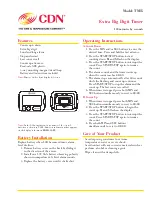
To avoid fire, shock, or death, turn off power at circuit breaker and test that power is off
•
before wiring.
Read instructions completely before installation and retain for future reference.
•
Observe all national and local electrical and safety codes.
•
Disconnect power when servicing or changing loads.
•
Alterations or modifications to the device will void the warranty.
•
For outdoor locations, rain-tight or wet location conduit hubs that comply with the re-
•
quirements of UL 514B Conduit, Tubing, and Cable Fittings, must be used.
GM40AV Series
General Purpose
Electromechanical Commercial Time Switches
To avoid fire, shock, or death, turn off power at the circuit breaker and test that
1.
power is off before wiring.
Open door and remove the interior protective cover by releasing the spring
2.
latch (see figure 1 below).
Remove the printed circuit board by releasing the spring latch holding the bot
-
3.
tom of the board (see figure 2 below).
Select knockouts to be used. Remove the inner 1/2” knockout by inserting a
4.
flathead screwdriver in the slot and carefully punch the knockout loose. Re
-
move slug. If 3/4” knockout is required, remove the outer ring with pliers after
removing the 1/2” knockout. Smooth edge with knife, if necessary.
Place the enclosure in the desired mounting location, and mark the three
5.
mounting holes (refer to Figure 3 below for dimensions). Install the top screw
first with one of the supplied spacers, and then hang the enclosure by the key
-
hole. Drive the remaining two screws at the bottom of the enclosure through
the mounting holes while passing each screw through one of the supplied
spacers and in to the wall.
Connect conduit hubs to conduit before connecting the hubs to the enclosure.
6.
After inserting hubs into enclosure, carefully tighten hub lock nut. Do not over-
torque.
Replace printed circuit board making sure to engage spring latch at the bot
-
7.
tom of PCB.
Wire in accordance with national and local electrical and safety codes (see
8.
wiring diagrams on page 3).
Grounding: Terminate all ground wires to the ground lug inside the case at the
9.
bottom of the enclosure.
Replace interior protective cover.
10.
INSTALLATION INSTRUCTIONS
ELECTRICAL RATINGS
N.O. Contacts:
40A Resistive @ 120~277VAC
1HP, 16FLA, 90LRA @ 120VAC
2HP, 12FLA, 52LRA @ 208~277VAC
30A Ballast @ 120VAC
20A Ballast @ 277VAC
15A Tungsten @ 120VAC
300VA Pilot Duty 120~240VAC
N.C. Contacts:
30A Resistive @ 120~277VAC
1HP, 12FLA, 30LRA @ 120VAC
2HP, 10FLA, 30LRA @ 240VAC
2A Tungsten @ 120VAC
10A Ballast @ 277VAC
WIRING CONNECTIONS:
Screw box lug terminals
ENVIRONMENTAL RATINGS:
Operating Temperature Range:
–40°F to 131°F (–40°C to 55°C)
Operating Humidity:
10 - 95% RH, non-condensing
ENCLOSURE DIMENSIONS:
8.795” x 6.631” x 2.935”
(H x W x D)
SHIPPING WEIGHT:
2 lbs.
AGENCY APPROVALS:
UL Listed
SETTING THE CLOCK TIME
Rotate the program dial gradually clockwise until the time of day on the outer
dial is nearly aligned with the triangle marker at the 2 o’clock position. Then set
time to the minute by rotating minute hand clockwise until the time of day (and
AM or PM) on the outer dial is aligned with the triangle marker on the inner dial.
NOTICE! Do not rotate the dial or minute hand counter-clockwise. Doing
so will damage the timer.
SETTING ON/OFF TIMES
Move the white tab (tripper) on the outer dial outward at the start of the desired
ON period. Move each adjacent tab outward until the desired OFF time is
reached.
(See illustrations on page 2)
PROGRAMMING INSTRUCTIONS
Figure 3 - Rear View of Enclosure
with mounting hole dimensions
6-1/8”
2-1/2”
Figure 2 - PCB Latch
Figure 1 - Spring Latch
Interior
Protective
Cover
Timer Mechanism
WARNING





















